Although they might seem like glorified tech toys, owning a high-quality drone can add immense value to your home security setup. Security drones can give you a unique view of the world, with endless applications for small and large properties.
Security Drones
Overview
The technology behind drones has come a long way in a very short time. Imagine a flying camera capable of monitoring crops, mapping acres of land, or inspecting those hard-to-reach areas in your property. And all with high video quality and stabilization!
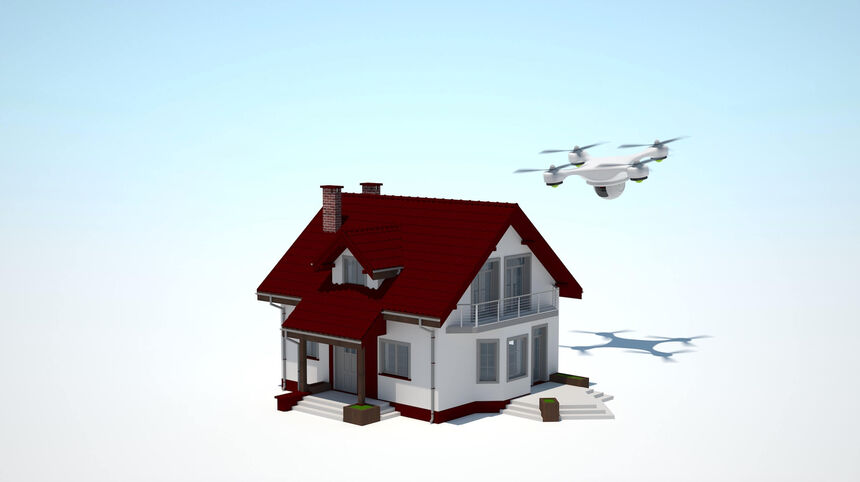 Home security using drones
Home security using dronesWhile drones are mostly known for cinematic projects or simply for fun, the applications have evolved towards a more warding-off territory. And combining it with a home security system will achieve an enhanced safety solution.
Security alarm systems come with state-of-the-art devices such as indoor cameras and home automation features. Unfortunately, most security cameras are somewhat static and limited to certain areas due to their preset field of view and lack of pan/tilt capabilities.
With a moving security camera patrolling your property from above, you will cover those out-of-the-way spots, like the ravine behind your house. Security drones also bring rural home security to a whole new level, allowing you to follow your cattle across acres of land.
But what is a drone exactly? Here at Home-security, we want to keep you informed on the newest developments towards the best safety features for your home and business. This article will explore these unique devices that can raise your home security system to a whole new level of protection. Let’s dig in!
What is a Drone?
In aviation, a drone implies an unpiloted aircraft, an Unmanned Aerial Vehicle (UAV) that doesn’t require rest. They gain loads of popularity in the military field, from mundane missions as surveillance to avoiding putting a pilot’s life at risk in combat zones.
 Drone security for your home
Drone security for your homeA drone’s autonomy level can vary, depending on the device. Some can be remotely piloted by a person controlling all its movements. Other drones have advanced autonomy, depending mainly on a set of sensors and detectors that calculate their actions.
Determined by the make and model, drones can travel different distances and heights. Hobbyists tend to own very close-range drones that travel up to three miles and are for personal use. In comparison, mid-range UAVs cover up to 400 miles and are used in scientific studies, meteorological research, and intelligence gathering.
Mounted onto the drone is a First Person View (FPV) camera that sends live images down to the ground using a video transmitter. These FPV cameras are small and light, allowing you to see where the drone is flying and what it is capturing in real-time. It will send the video signal to a remote-control screen, smartphone device, or monitor.
This FPV technology has revolutionized the drone industry and its application. The first-person perspective gives the controller a feeling like he is piloting the aircraft from a cockpit view instead of standing on the ground and looking up.
Unfortunately, the FPV drones’ ability to fly at significant altitudes beyond the pilot’s visual range has raised many safety concerns. They could crash into buildings, interfere with airspace, or endanger people and property on the ground.
In the U.S., the Federal Aviation Administration (FAA) has regulated the commercial use of drones. They advise that operators can only fly during daylight or twilight, with speed and altitude restrictions. Check the guidelines before buying any security drone, as you might require to register it with the FAA.
There are many low-cost drones in the market under $100. The downside is that they are typically constructed from light foam-based materials. Others are more solid models with flight-stabilization technology and high-definition integrated cameras. They start at around $300 and go up from there.
Types of Drones
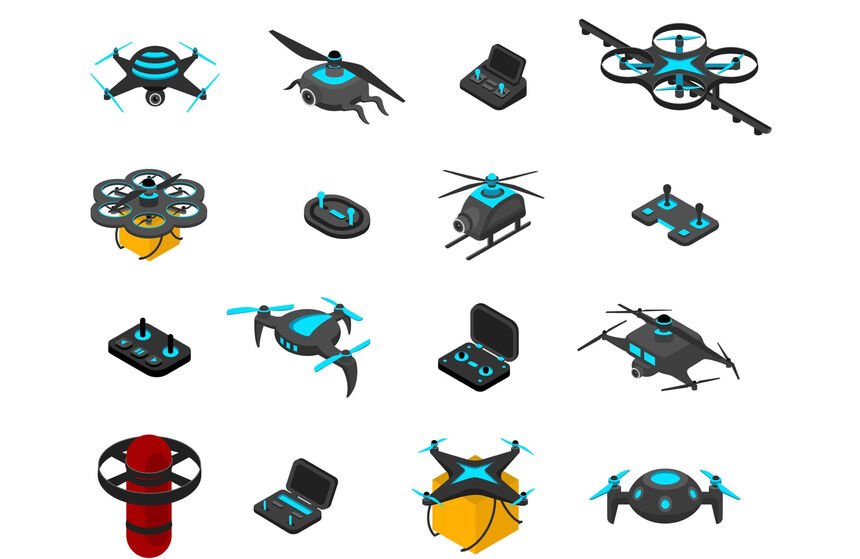 Types of drones available
Types of drones availableSingle-rotor Helicopters:
A single-rotor helicopter looks like a tiny helicopter with a single rotor to hold it up. The tail rotor that controls its heading helps the drone’s stability and allows it to fly for longer distances.
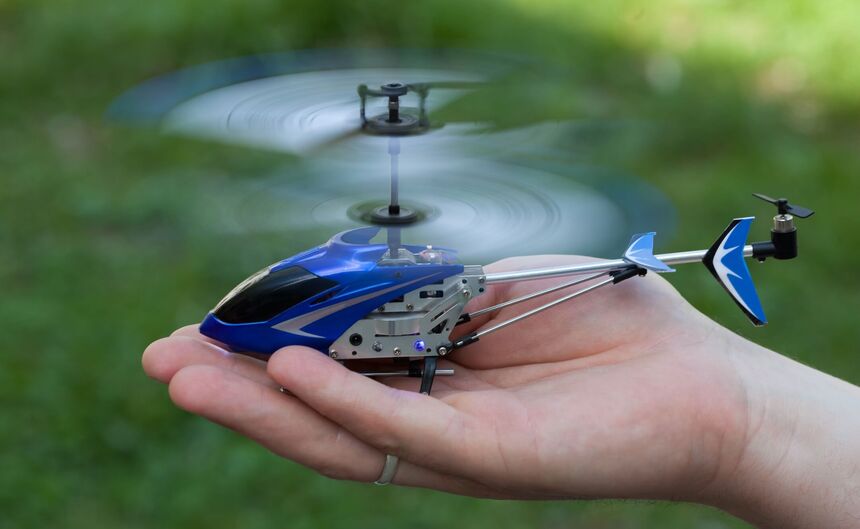 Single-Rotor Drone
Single-Rotor DroneSingle rotors are usually powered by lithium-polymer (LiPo) batteries or a gas motor for prolonged endurance. These UAVs allow for exceptionally long blades similar to a spinning wing than a propeller, making them more effective.
In terms of flight difficulty, single-rotor drones can hover on the spot and fly fast forward. It is ideal for heavy cargo like an aerial Light Detection and Ranging (LIDAR) laser scanner. It is used mainly to mapping terrains or research weather conditions.
On the downside, they require a lot of maintenance due to their complexity. Plus, the large spinning blades can be dangerous, causing severe damage if you get in their way. And although they might be easy to manage, the single rotors aren’t as stable in the event of a bad landing.
Multi-Rotor Drones:
If you want a smaller and lighter camera in the air, Multi-rotor drones are the way to go. They usually have limited speed, height, and distance but make the perfect flying tool for aerial photography.
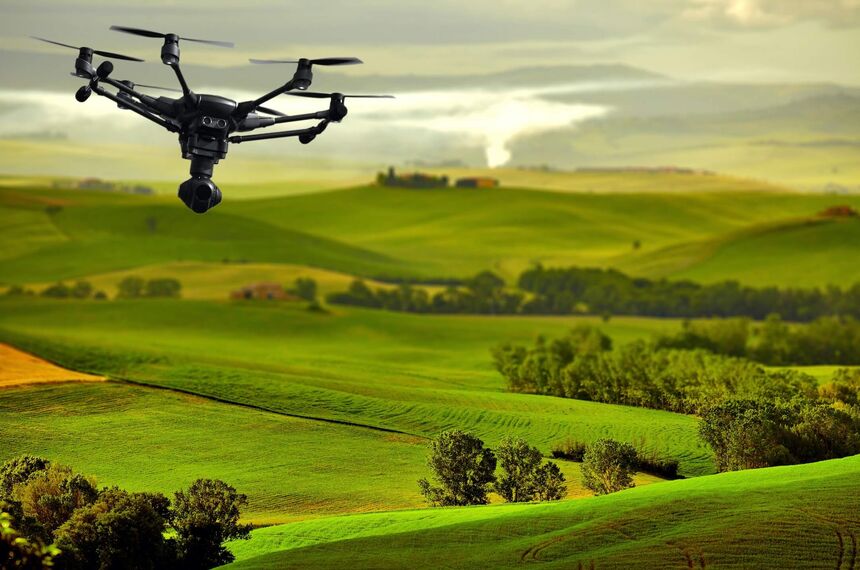 Multi-Rotor Drone
Multi-Rotor DroneMulti-rotor drones operate as agile camera platforms that can spend 20-30 minutes in the air. They can carry a lightweight payload, like a high-quality camera while hovering in tight spaces.
These UAVs have grown in popularity among FPV pilots. They are more accessible and not as expensive as other more complex drones. Multi-rotors are easier to steer and deliver better control over position and framing, perfect for getting an eye in the sky.
The main disadvantages of multi-rotor drones are their limited speed and endurance. They require a lot of energy to keep them in the air, making them unfit for long-distance monitoring or large-scale aerial mapping.
With the current battery technology, multi-rotors can fly for around half an hour while carrying a lightweight camera. Heavy-lift rotors can carry more weight but for shorter flight times. It isn’t feasible to switch to gas engines due to the need for high-precision throttle changes that keep them stabilized.
Fixed-Wing Drones:
Fixed-wing drones look like regular medium-size airplanes with large wings and space for video equipment. These drones are capable of supporting extra weight and usually use fuel instead of electricity.
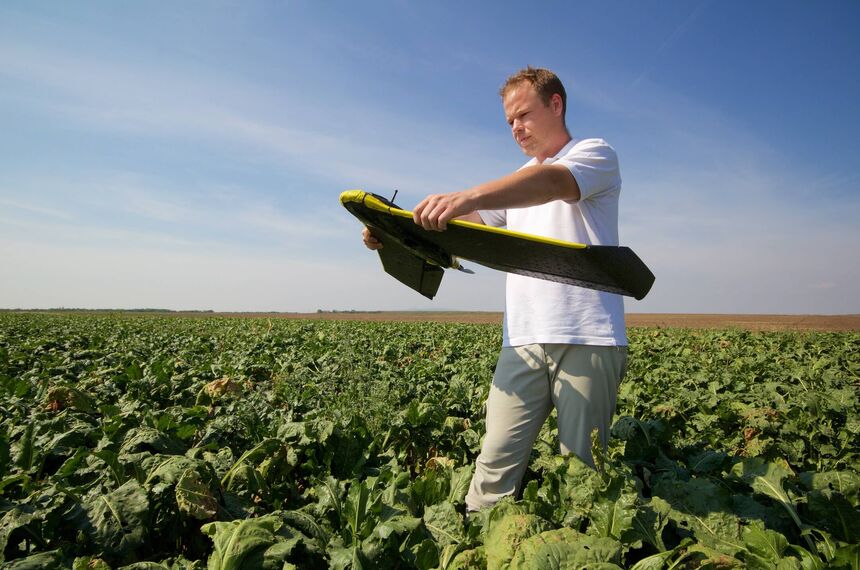 Fixed-Wing Drone
Fixed-Wing DroneThe wings provide the lift instead of vertical lift rotors, making them more efficient. They only need to move forward and not hold themselves up in the air. As a result, they can cover longer distances, map more extensive areas, and longer monitoring time.
But capturing images with a fixed-wing drone is not just as simple as taking pretty pictures like a single or multi-rotor drone. You acquire the data, but the imagery is not instantly ready to hand over. The hundreds of separate images need to be processed and stitched into one tiled image for a final result.
Due to their design and more considerable size, fixed-wing drones need to take off and land on runways the same as airplanes do. The military commonly uses them to conduct dangerous missions, scientists to carry equipment, and nonprofit organizations to deliver food in hard-to-reach areas.
Fixed-wing drones can glide for 16 hours or more, thanks to the greater energy density that comes with fuel use. UAV pilots tend to favor them since they provide higher speed, clearer maneuverability, larger wing surface area, and better gliding ability.
The major drawback is the inability to remain in one spot, ruling them out for aerial photography or fixed-area surveillance. Compared with other UAVs, fixed-wing drones need a more extensive learning process, unlike a multi-rotor drone that you can buy and start practicing in the backyard.
Plus, fixed-wing drones are usually on the higher cost side, and the launching and landing are a lot more complicated than other types of drones. You will need a runway or some sort of landing strip to get them airborne and a net or parachute to safely recovering your aircraft.
Benefits of Drone Surveillance
Besides the incredible aerial pictures or the bragging right of owning such a cool “toy,” a drone could benefit other areas in your life. From personal use to commercial applications, the pros of having eyes in the ski around your property are endless. Here are some of the most outstanding advantages of drone surveillance:
 Benefits of Drone Surveillance
Benefits of Drone Surveillance• Use the drone’s camera to map your property and find weak points. It will help you figure out where to set up other security components like outdoor cameras and smart lights to enhance your home alarm system.
• If you are having an event on a huge venue, you can map out the area for vulnerabilities and give the security team the info they need to place their forces accordingly.
• During a possibly dangerous situation, sending a drone to the rooftop of a building will make the response time is much faster. You can see what is happening and call the proper authorities for assistance.
• Drones can run a perimeter route faster and easier, helping investigate disturbances. It will keep your employees safer, evacuating the grounds or spotting potential danger in a faster time frame.
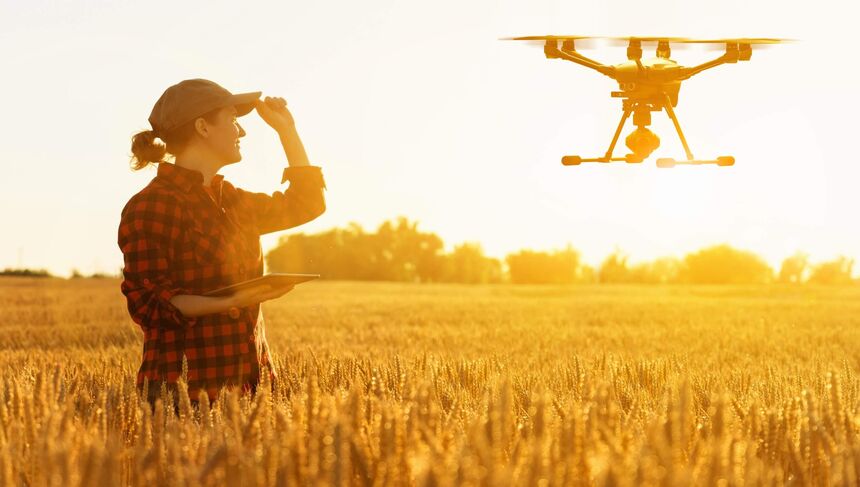 Applications for Drone Surveillance
Applications for Drone Surveillance• Check blind spots from afar, minimizing the risk of confrontation with a prowler lurking in the shadows.
• Track a burglar from above and feed the police or your security team the information required to catch him. Pinpoint the location and follow discreetly through any obstructions so they can apprehend him.
• Just as having a security system on display, a drone can also be used to deter intruders. The noise from the rotors and hovering over can scare away a burglar trying to break into your property.
Of course, with new technology comes its own set of shortcomings. The main concern about drones is privacy. You don’t want your neighbor’s drone hovering over your backyard or a suspicious bystander taking photos of your home.
Another concern is cybersecurity. Drones are susceptible to being hacked just like any other smart device. Regrettably, hackers get more competent at spotting vulnerabilities in drone security, making it serve their purposes. And as the population of drones keeps growing, so will the cybersecurity issues will arise.
Applications for Drones
Probably the most well-known use of drones is in the military field, taking on some of the most challenging jobs in the world. Government agencies use drones for safety reasons to help them gather intelligence, map a terrain, or have an “eye-in-the-sky” view during extreme situations.
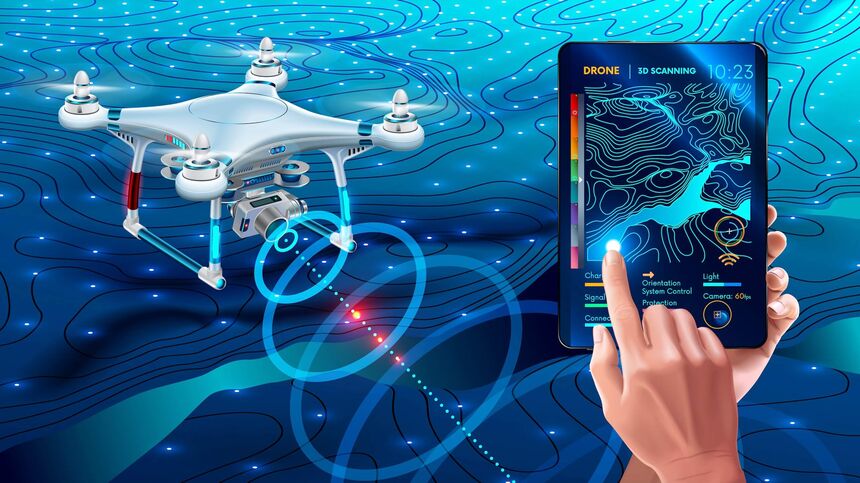 Applications for drones
Applications for dronesDrones are a handy tool during emergencies too. They can monitor hurricanes or look for those caught in an avalanche without putting pilots at risk. Drones can help during search-and-rescue operations on rough terrains to find survivors. They are also used to deliver emergency medical supplies in hard-to-reach areas for a fast response.
In recent years, the drone business took on a more commercial turn. These crafts carry out an impressive range of unique tasks. Big companies like FedEx and UPS are considering sending drones to drop off packages.
Amazon is leading the pack with a new service called “Prime Air,” with its first autonomous drone delivery in Britain back in 2016. Although it is still in the works, this futuristic delivery system is designed to deliver packages under five pounds to customers in 30 minutes using drones.
Other heavyweight brands like Walmart and Google are currently testing different versions of delivery drones. They can be used to transport packages or food from stores or warehouses close by. Retailers are turning to drone technology for a more efficient delivery alternative, as these drones could carry up to 55 pounds of goodies to your doorstep.
Another great practice that has boomed in the last years is aerial shooting. Photo enthusiasts and pros turn to drones for the incredible footage of landscapes, cities, or their favorite beach from high in the sky. These unique images cannot be achieved in any other way.
Drone Solutions for Security
Flying a drone could be a lot of fun, and it allows you to capture images and video that you wouldn’t get from ground level. But security drones deliver so much more, providing real-time insight into any emergency situation.
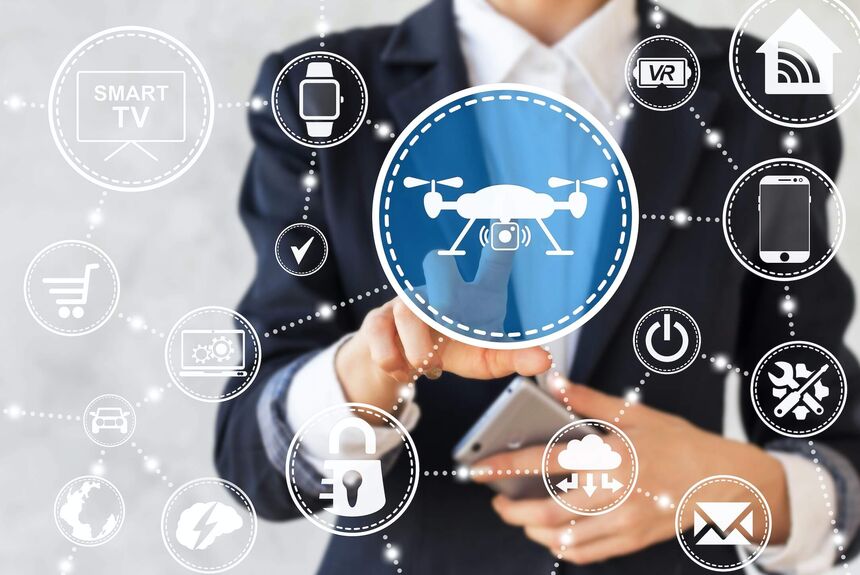 Drone Solutions for Security
Drone Solutions for SecuritySecurity drones can assist your security system with instant visibility from possible threats, helping security officers and emergency responders be well informed of the situation. Companies like Airobotics have developed an industrial drone with a fully automated platform ready to patrol your estate on demand.
The automated industrial drone can address the unique needs of complex industrial environments. It is more durable, built with corrosion-resistant and weatherproof materials with advanced surveillance and mapping technology. The system is perfect for extensive industrial facilities such as mining, oil and gas, and seaports.
Another big player is Sunflower Labs. It has developed a new product that could change how we regard outdoor home safety. The Sunflower Home Awareness System is a new home security system that includes motion/vibration sensors and drones to guard your home.
The Sunflowers sensors mimic garden lights that can detect people, cars, and animals on your property. It is combined with a fully autonomous drone called The Bee, a high-quality UAV packed with cameras that capture stunning footage and geofencing/object-avoidance technology.
It will never fly away or crash into your trees thanks to its learning capabilities and reactions to its surroundings, improving over time. If you want this innovative platform patrolling your property, get ready to pay the big bucks. The company is accepting pre-orders, and the price starts at $9,950 and could go up depending on your specific needs.
For indoor use, nano drones easily fit in the palm of your hand and are safe enough to fly inside your home. These drones are primarily for recreational use, not suited for a security setup. There are no indoor security drones in the market… Yet!
In 2020, Amazon announced its next-level home security device, the Ring Always Home Cam. It delivers a unique way to monitor your home in a manner that has never been done before: an autonomously flying indoor security camera.
The Ring Always Home Cam will fly around on a preset route inside your home, capturing everything on its path. The company states that the camera is designed for simple tasks. It will integrate smoothly with the Ring Alarm security system.
It is one of Ring’s most bold ventures so far, a surveillance camera that provides multiple viewpoints from within your home. The objective is to have access to specific areas without having to purchase several cameras. The Ring Always Home Cam retails for $250 and will be available in 2021.
As you can see, security drones are an expensive investment, so you might have to stop considering them as glorified toys. Please take into consideration the maintenance and training some of them require. It pays to do your due diligence before buying a security drone or any new smart device.
Bottom Line
Drones are an ideal tool for strengthening your security force. A drone can fly a path faster and more effectively than a person, dodging obstacles and identifying threats from a distance.
 Drones are an ideal tool for strengthening your security force
Drones are an ideal tool for strengthening your security forceAdding a security drone to your alarm system will provide a faster response time. It can cover larger areas and hard-to-reach places, like your rooftop or a forested section of your property.
Sending a drone to investigate any disturbance helps minimize the risk of exposure, assist law enforcement track down an intruder, or even deter them by their presence. And with their incorporated cameras, you can take a picture and hand it over to the police to identify the perpetrator and apprehend him faster.
Plus, drones provide other key applications we have discussed throughout this article. Photographers gain a vital tool for their photoshoot sessions while a police task force gains an airborne ally to catch the bad guys.
Given the possibilities, drone use will create a bigger market for commercial and residential use. The development of better UAVs with a longer battery life will improve your home security, opening new and unique ways to monitor your home. The future of drones is up for grabs. The sky is the limit!
 Menu
Menu